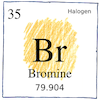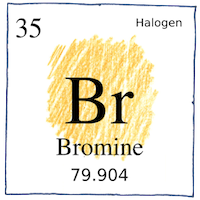Heidelberg—Carl Jacob Löwig, Leopold Gmelin, Antoine Jérôme Balard
elements

|
Bromine
Carl Jacob Löwig and Antoine Jérôme Balard independently found bromide. Löwig isolated it from waters of a mineral spring at his hometown, Bad Kreuznach, and took it to his professor Leopold Gmelin who recognized it as a new element. Balard extracted it from ash of seaweed from the salt marshes of Montpellier. He proved it wasn’t iodine monochloride and concluded it was a new element.
Atomic number 35
Bromine is a red-brown liquid similar to chlorine and iodine that fumes at room temperature to form a corrosive and toxic vapor. It forms a colorless soluble crystal as a halide salt. It is used in flame retardants and flame-resistant polymers, in insecticides, and in disinfectants for hot tubs. Its uses as a sedative, and as a soil fumigant to protect strawberries from nematodes, have been discontinued.
Rare dyes
The rare purple dye, Tyrian purple, an organic compound of bromine, extracted from the secretions of the predatory sea snail Murex brandaris, was reserved for rulers of the Byzantine Empire and Charlemagne the Emperor of Europe, until the dye works in Constantinople was destroyed and European royalty adopted carmine extracted from the bodies and eggs of cochineal insects. Doesn’t it seem as though the symbolic importance of a thing is far more important than its rarity, although there does seem to have been a certain correspondence between the two?



Bromine, hydrogen, nitrogen, oxygen, fluorine, chlorine, and iodine are nonmetals that exist naturally in a diatomic state. Even though it is toxic in its pure elemental form, it is essential for all animals, required for the formation of collagen.
See also in The book of science:
Readings in wikipedia:
Other readings: